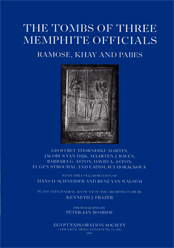General information on Pabes’ tomb
Pabes, whose tomb is situated directly behind that of Khay, was the latter’s (eldest?) son. Like his father, he acted as a Troop-commander of Traders, though in his case his employer appears to have been the Memphite temple of Ptah. Since Pabes is not represented in his father’s tomb,
he may have predeceased him and in that case Khay himself may have paid for the funerary monument. This means that the tomb is roughly contemporaneous with that of Khay himself: second half of the 19th or beginning of the 20th Dynasty (c. 1250-1175 B.C.). Pabes’ monument was excavated in 1986.
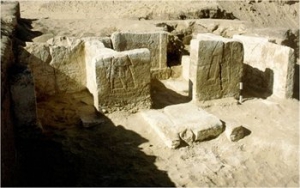
Superstructure of Pabes’ tomb
The tomb-chapel of Pabes has a tripartite plan. The central, and largest, of the three chapels served as the offering-room. The side-chapels were no mere magazines, because they also comprise relief decorations. Moreover, one of the chapels seems to have contained the cow statue now in the Leiden Museum. The tomb as a whole bridges the distance between the tombs of Horemheb in the south and Ramose in the north. Like the chapel of Khay, it stands on a platform of rubble, about 85 cm above the pavement level of its neighbours. The architecture of Pabes’ tomb is mediocre, the limestone blocks are roughly worked, and are held together with liberal applications of plaster. The most interesting decorative elements are a stela against the west wall of the central chapel and a harbour scene showing the unloading of ships on the north wall.
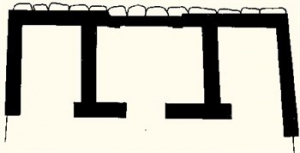
Substructure of Pabes’ tomb
The shaft of Pabes lies directly in front of his central chapel and is 4.03 m deep. It gives access to two chambers: one in the north (a) which has two side-niches for mummies (b and c), and another in the south (d) with one such mummy-niche (e). All chambers are irregularly cut from the rock. They still contained some plundered remains of the original burial ensemble, including several shabtis of Pabes and other persons. In niches c and e there are breakthroughs to other shafts.
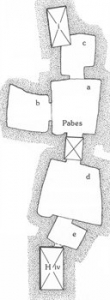
Most interesting finds from Pabes’ tomb
Shabtis
The underground tomb-chambers of Pabes had clearly been plundered in antiquity. Still, the remains of a set of blue faience shabtis could be recovered from the substructure or the desert surface surrounding the shaft’s aperture. Several of these were broken but could be rejoined by the expedition. They show that Pabes possessed at least twelve shabtis of three different types. Eleven shabtis show him as a mummy; seven bear an inscription for ‘the scribe of the treasury Pabes’, whereas the other four give his title as ‘troop commander’. The twelfth figurine depicts Pabes in the dress of daily life, while clasping a ba bird to his chest. Such a number of shabtis is not unusual in the Ramesside period. Later the number gradually rose to include 400 figurines from the Third Intermediate Period onwards. These symbolized the days of the year, with an overseer for each group of ten.
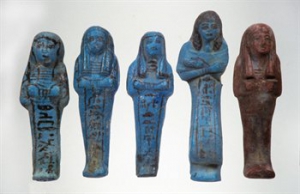
Canopic jars
Probably these two fragments belonged to a canopic jar of Pabes. This is suggested by the occurrence of the title ‘true scribe of the Lord of the Two Lands’ on the upper fragment. The same title can be read on the walls of Pabes’s tomb-chapel, and one of the sherds was found in his tomb-chambers. It is remarkable that the jar in question was made in two parts, since the bottom fragment shows a straight upper edge. This sheds some light on the relative poverty of the burial. The interior walls of the fragments are coated with a black crust of resinous material, as one would expect for a vessel which contained the embalmed intestines of the deceased. The exterior is painted in black with a stylized lotus frieze and a scene of the deceased adoring the god Osiris. No trace has been found of the other three jars forming a set.
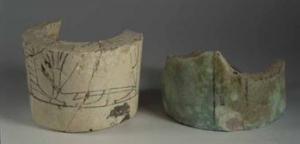
Pabes’ family relations
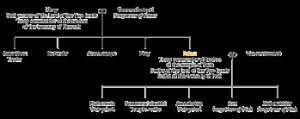
Objects from Pabes’ tomb in museum collections
Leiden, Rijksmuseum van Oudheden AM 108: group statue of couple with Hathor cow
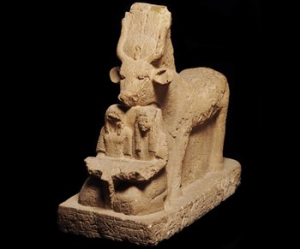
Restoration
After the 1986 excavation of the tomb of Pabes, it was immediately protected by the expedition. To this end a modern limestone wall was erected around the tomb, which supports a wooden roof with a thin top layer of concrete. In spite of these precautions the reliefs, which were executed on bad quality limestone, have much suffered in the meantime. Therefore, wooden doors were added during the 2007 restoration campaign.
Bibliography
Final report:
Martin, G.T., et al., The Tombs of Three Memphite Officials, Ramose, Kha’y and Pabes (London, 2001).
